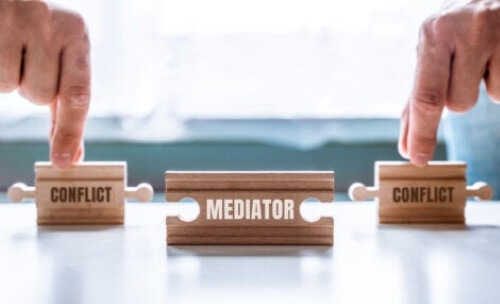Managing Conflicts Through Mediation


Written and verified by the psychologist Ana Couñago
It’s important that children know how to deal with conflictive situations and what to do when they encounter problems in daily life. They need to learn how to handle conflicts without resorting to violence or losing control of their emotions. Therefore, in this article, we’re going to address the subject of managing conflicts through mediation.
This strategy of conflict resolution helps to analyze, regulate, and resolve problems in a conciliatory way that is constructive and cooperative. For example, this is very beneficial for the social development of small children because they learn in the first years of life how to tolerate others. Moreover, they find solutions to conflicts in a positive way.
“We cannot solve problems by thinking in the same way as when we created them.”
– Albert Einstein –
Managing conflicts through mediation
According to Juan Carlos Torrego, Doctor of Educational Sciences, mediation can be defined as:
“A method of conflict resolution where the two conflicting parties voluntarily appeal to a third impartial party or mediator, to arrive at a satisfactory agreement.”
– Juan Carlos Torrego –

Based on this definition, you can say that this technique of conflict resolution is characterized by the existence of the following:
- The voluntary consent of both of the parties
- A predisposition and effort on the part of both parties to communicate. Likewise, they should seek to understand the other’s point of view and arrive at an agreement.
- The external intervention of someone that acts as the mediator
In this way the mediator will carry out the following functions in helping to manage conflicts:
- Control the whole process, without emitting value judgments and without assigning blame or final responsibility
- Help the parties to understand each other, negotiate and resolve the conflict
- Assist the involved parties in identifying their interests and satisfying their needs
- Encourage an agreeable climate. For example, the climate should be relaxed and inspire trust throughout the process.
- Facilitate discussion so the parties express their opinions and fully develop their perspectives
- Propose a way to reach an agreement. In addition, look for the best solution possible for both parties
In this way, both sides who find themselves involved in the conflict have the obligation to participate and to actively try to reach a compromise. They’re in the mediation process with the goal of finding a mutually beneficial solution to the disagreement.
So, this will help both parties to reason through the dilemma and to overcome their problem in a healthy and diplomatic way.
The phases of mediation
To put the strategy of mediation into practice, it’s necessary to follow a series of phases. These phases are presented below:
1. Explain briefly what mediation consists of and present the rules that need to be followed.
2. Decide who begins to present their point of view on the problem.

3. Explain what happened. Each party should describe the conflictive situation as well as their thoughts and feelings in respect to the conflict. Therefore, in this phase the mediator should do the following:
- Listen actively
- Assure that both parties express themselves in an assertive way
- Identify the most important aspects of the problem
- Record the points of agreement and those where they continue to have a conflict
Managing conflicts: further steps in mediation
4. Clarify the essence of the disagreement: The mediator should ask questions that they feel are pertinent. The aim of this is to help deepen understanding and to make the problem more concrete. Therefore, in this stage, the aim is to get a mutual picture of the conflict, that should bring in the opinions of both parties.
5. Propose solutions. Brainstorm ideas where both parties involved propose different ways of resolving the conflict.
6. Reach an agreement. The mediator should value all proposals at this stage. The advantages and disadvantages of each proposal are analyzed with the objective of finding the most viable solution that is beneficial for everyone.
7. Draw up an agreement. Meanwhile the mediator authors a document where they clearly specify what solution was agreed upon. In addition, both parties express their commitment. This also serves as evidence that a mutual understanding was reached.
8. Revise the agreement periodically: Finally, it’s necessary to track the outcome and prove that they’re abiding by what is established in the contract.
“It is not possible to untie a knot of which one does not know.”
– Aristotle –
It’s important that children know how to deal with conflictive situations and what to do when they encounter problems in daily life. They need to learn how to handle conflicts without resorting to violence or losing control of their emotions. Therefore, in this article, we’re going to address the subject of managing conflicts through mediation.
This strategy of conflict resolution helps to analyze, regulate, and resolve problems in a conciliatory way that is constructive and cooperative. For example, this is very beneficial for the social development of small children because they learn in the first years of life how to tolerate others. Moreover, they find solutions to conflicts in a positive way.
“We cannot solve problems by thinking in the same way as when we created them.”
– Albert Einstein –
Managing conflicts through mediation
According to Juan Carlos Torrego, Doctor of Educational Sciences, mediation can be defined as:
“A method of conflict resolution where the two conflicting parties voluntarily appeal to a third impartial party or mediator, to arrive at a satisfactory agreement.”
– Juan Carlos Torrego –

Based on this definition, you can say that this technique of conflict resolution is characterized by the existence of the following:
- The voluntary consent of both of the parties
- A predisposition and effort on the part of both parties to communicate. Likewise, they should seek to understand the other’s point of view and arrive at an agreement.
- The external intervention of someone that acts as the mediator
In this way the mediator will carry out the following functions in helping to manage conflicts:
- Control the whole process, without emitting value judgments and without assigning blame or final responsibility
- Help the parties to understand each other, negotiate and resolve the conflict
- Assist the involved parties in identifying their interests and satisfying their needs
- Encourage an agreeable climate. For example, the climate should be relaxed and inspire trust throughout the process.
- Facilitate discussion so the parties express their opinions and fully develop their perspectives
- Propose a way to reach an agreement. In addition, look for the best solution possible for both parties
In this way, both sides who find themselves involved in the conflict have the obligation to participate and to actively try to reach a compromise. They’re in the mediation process with the goal of finding a mutually beneficial solution to the disagreement.
So, this will help both parties to reason through the dilemma and to overcome their problem in a healthy and diplomatic way.
The phases of mediation
To put the strategy of mediation into practice, it’s necessary to follow a series of phases. These phases are presented below:
1. Explain briefly what mediation consists of and present the rules that need to be followed.
2. Decide who begins to present their point of view on the problem.

3. Explain what happened. Each party should describe the conflictive situation as well as their thoughts and feelings in respect to the conflict. Therefore, in this phase the mediator should do the following:
- Listen actively
- Assure that both parties express themselves in an assertive way
- Identify the most important aspects of the problem
- Record the points of agreement and those where they continue to have a conflict
Managing conflicts: further steps in mediation
4. Clarify the essence of the disagreement: The mediator should ask questions that they feel are pertinent. The aim of this is to help deepen understanding and to make the problem more concrete. Therefore, in this stage, the aim is to get a mutual picture of the conflict, that should bring in the opinions of both parties.
5. Propose solutions. Brainstorm ideas where both parties involved propose different ways of resolving the conflict.
6. Reach an agreement. The mediator should value all proposals at this stage. The advantages and disadvantages of each proposal are analyzed with the objective of finding the most viable solution that is beneficial for everyone.
7. Draw up an agreement. Meanwhile the mediator authors a document where they clearly specify what solution was agreed upon. In addition, both parties express their commitment. This also serves as evidence that a mutual understanding was reached.
8. Revise the agreement periodically: Finally, it’s necessary to track the outcome and prove that they’re abiding by what is established in the contract.
“It is not possible to untie a knot of which one does not know.”
– Aristotle –
All cited sources were thoroughly reviewed by our team to ensure their quality, reliability, currency, and validity. The bibliography of this article was considered reliable and of academic or scientific accuracy.
- Suárez-Sandomingo, J. M. S. (Ed.). (2005). Mediar para remediar conflictos. Lugo: Axac.
- Torrego, J.C. (2000): Mediación de conflictos en instituciones educativas: manual para la formación de mediadores. Madrid. Narcea.
This text is provided for informational purposes only and does not replace consultation with a professional. If in doubt, consult your specialist.








